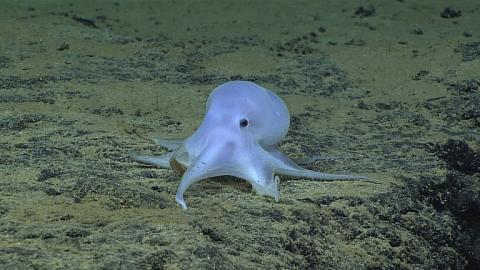
Caspar the Ghost Octopus
A social media celebrity was born last week when the bright lights and camera of NOAA’s remotely operated vehicle Deep Discoverer zoomed in on a ghostly white octopod alone on a sediment-covered rock some 2½ miles deep in the ocean near the Hawaiian Archipelago. Its lack of pigment cells—called chromatophores—led internet viewers to suggest naming it Casper, after the friendly cartoon ghost. Internet blogs and news pages turned the octopus into an overnight cephalopod sensation.
“What’s really remarkable is that this is a fairly charismatic organism that we didn’t even know it existed until less than a week ago,” says Michael Vecchione, Zoologist at NOAA Fisheries’ National Systematics Laboratory and Curator of Cephalopods at the Smithsonian’s National Museum of Natural History. “It’s a really good example of how little we know about life in the deep sea. And of course, the deep sea is most of the living space on our planet. So it’s a good illustration of how little we know about life on our own planet.”
While the octopod is almost certainly an undescribed species, Vecchione says, truth be told, “new species in the deep sea are a dime a dozen.” What’s most notable is that “it is the deepest record for this type of animal—an incirrate octopod.” Incirrate octopods, unlike deep-sea “dumbo” octopods, have no fins on the sides of their bodies and no finger-like structures near the suckers on their arms. Incirrates are common in shallow water.
